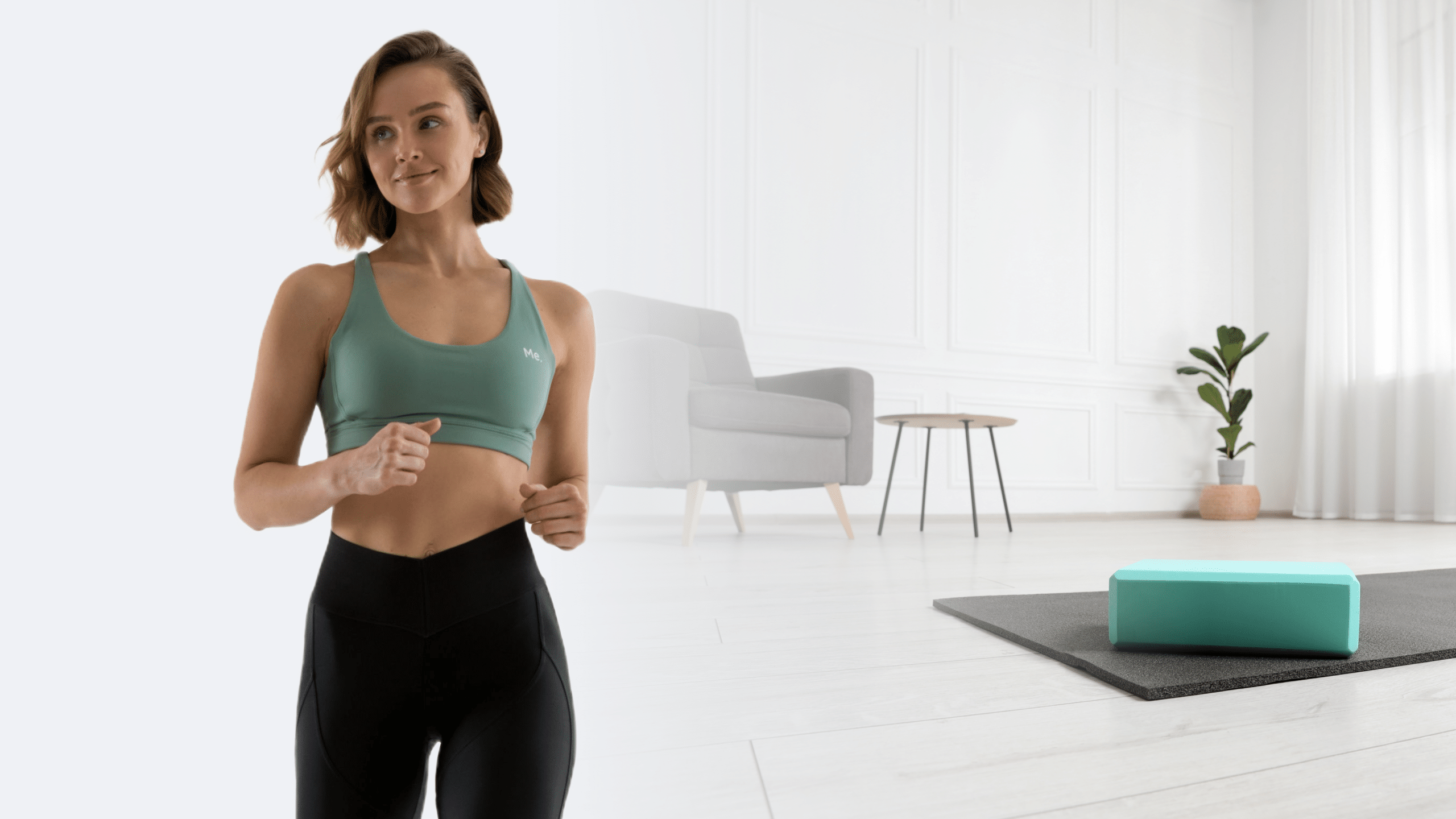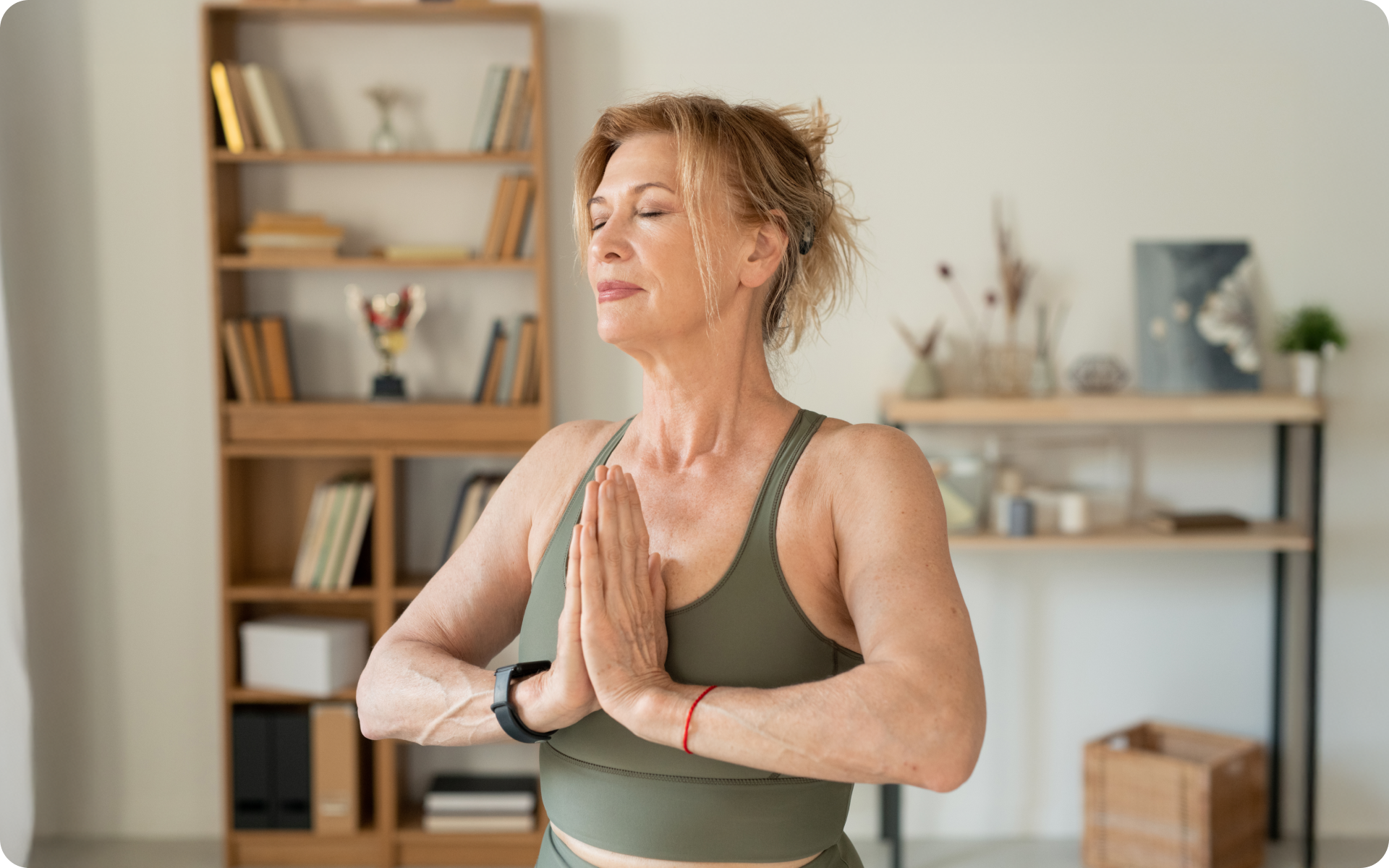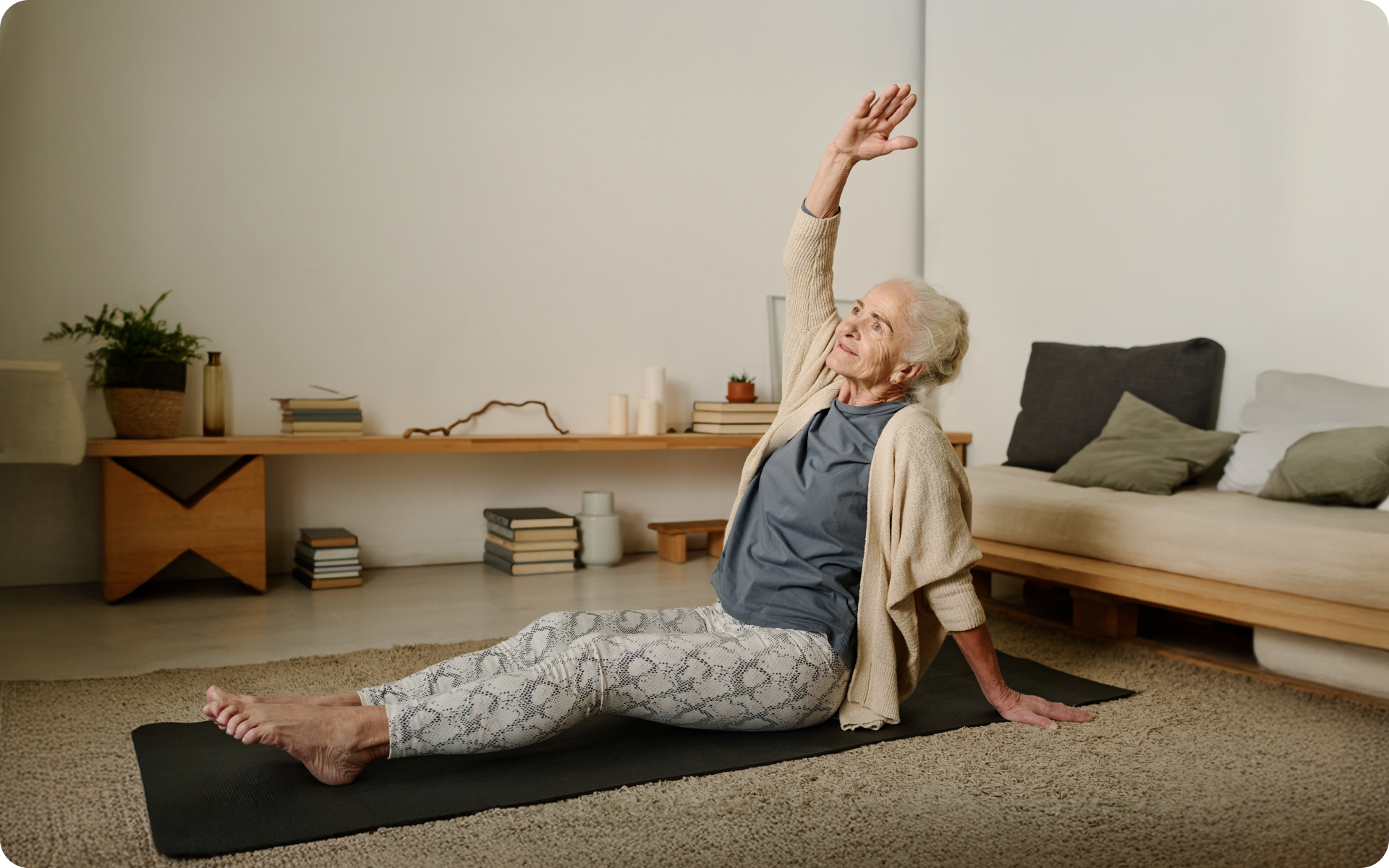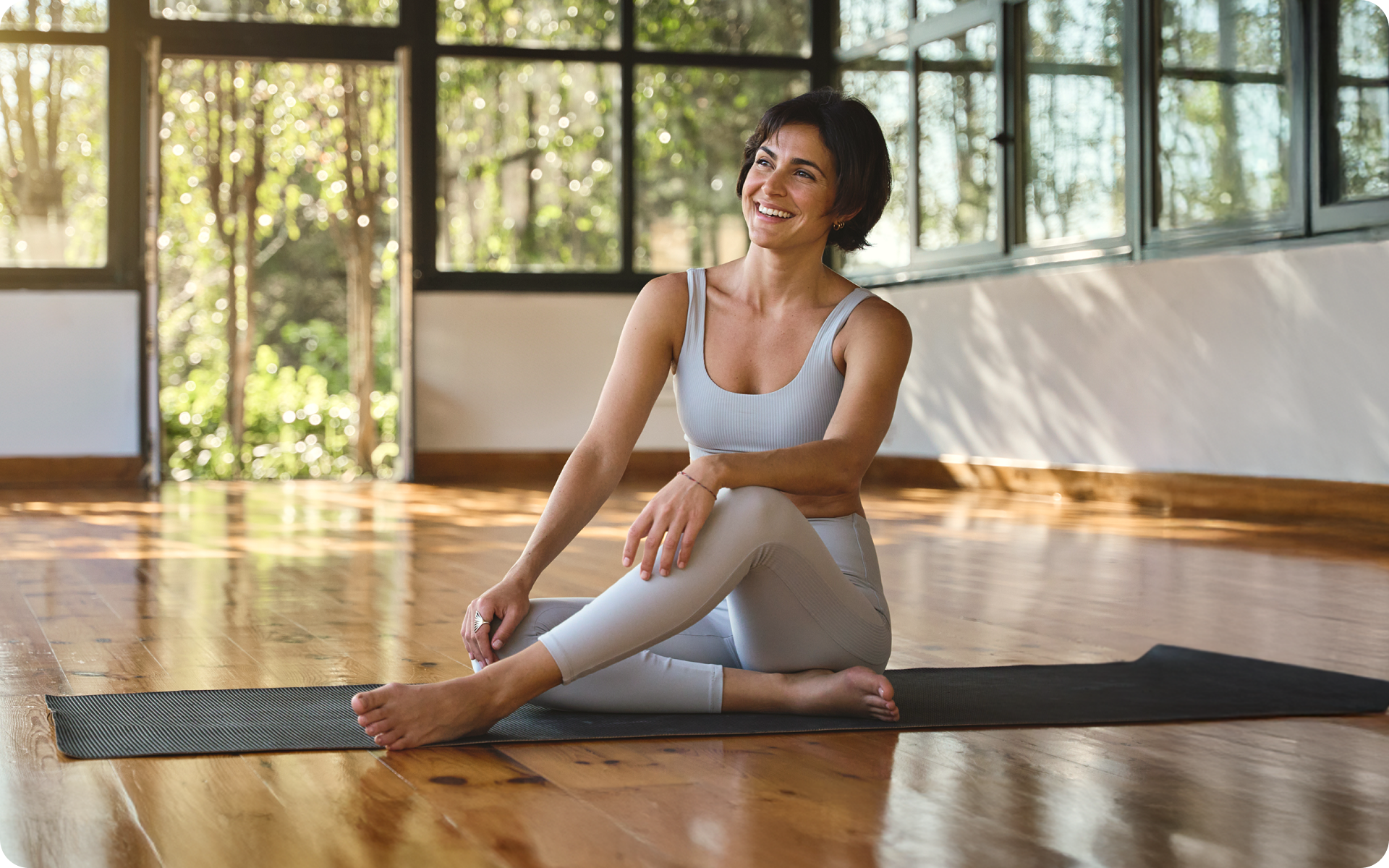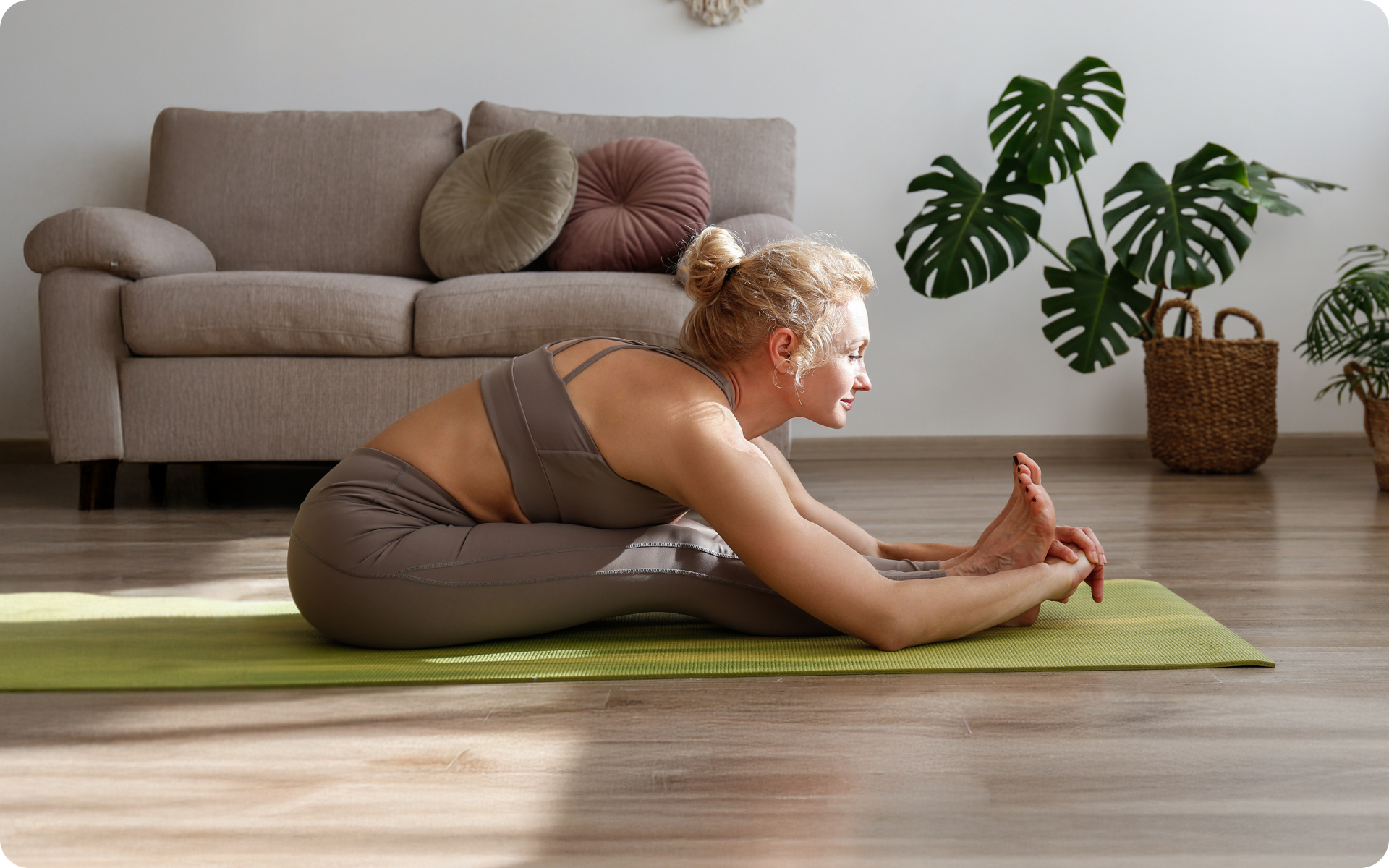Recent statistics have shown that women shoulder 75% of the world’s unpaid care and domestic work (10). Sadly, you’re likely to fall into this bracket, even if you’re juggling a full-time job outside of your home duties.
Added to this is the often silent battle with postpartum depression, a common health problem relating to the physical and emotional upheaval that follows childbirth – although research on this subject is still emerging (9).
So when you find yourself needing a break, yearning for a moment of tranquility amid the chaos, where do you turn?
Yoga, which is known for its power to soothe the mind, strengthen the body, and uplift the spirit, is a very welcome solution (4). It’s a practice that has been embraced by millions all over the world for its holistic benefits.
Here’s everything you need to know about incorporating yoga into your busy schedule, in the simplest, most accessible way possible.
Can I Learn Yoga at Home by Myself?
Technically, you can learn yoga at home by yourself. Most things in life can be learned if you have the right mindset and information. But thinking in this way can sometimes oversimplify the nuanced journey of learning yoga.
Yoga is not only a physical exercise, it is a practice that integrates the body, mind, and spirit (4).
It’s certainly possible to learn the physical poses (asanas) at home from books, videos, or apps, but the deeper aspects of yoga may be difficult to grasp without the guidance of a knowledgeable teacher.
A yoga instructor will provide correct postures and alignments while also explaining the significance of each pose and how it benefits your body and mind. They can also offer real-time feedback and adjustments, something that a video or book simply cannot provide.
Yoga instructors also cultivate a community, a sense of belonging that can be incredibly supportive as you start on your yoga journey.
This doesn’t mean that self-learning is off-limits. If you’re disciplined, patient, and have a good understanding of your body’s limits, then yes, you can reap the yoga for moms benefits. However, it’s always beneficial to occasionally attend a class, workshop, or yoga retreat to deepen your understanding.
Reasons why BetterMe is a safe bet: a wide range of calorie-blasting workouts, finger-licking recipes, 24/7 support, challenges that’ll keep you on your best game, and that just scratches the surface! Start using our app and watch the magic happen.
Beginner Yoga Poses for Moms
Here are some yoga for moms beginners poses you can try at home (note, you don’t have to do all of them in the order we’ve listed and creating a sequence of poses is a creative way to practice):
Easy Pose (Sukhasana)
This is a cross-legged sitting position, which is the basis of many seated poses. It’s an excellent way to calm your mind and ground yourself, just as we mentioned in our discussion on chair yoga for stress relief.
So, what will this pose do for the stay-at-home mom? Firstly, it will help you improve your posture and open up your hips. It’s also a perfect starting place for meditation or to take deep breaths if you’re feeling overwhelmed.
As it involves minimal physical effort, you can use this pose as a means of easing into your yoga practice, particularly if you have any physical limitations. It’s a must for mom and baby yoga; you can sit and sway together, or do some gentle stretches while you bond with your little one.
- Find a quiet, calm space at home where you can practice yoga uninterrupted.
- Lay down a yoga mat or a thick blanket to sit on. This will provide comfort and stability.
- Sit on the edge of the mat or blanket, extending your legs out in front of you.
- Cross your legs at the shins. Make sure your knees are below your hips and your feet are underneath your knees.
- Rest your hands on your knees or thighs, palms facing up or down.
- Straighten your back, ensuring your spine is aligned. Relax your shoulders and allow them to fall away from your ears.
- Gently close your eyes or maintain a soft gaze if you prefer.
- Breathe deeply and evenly, focusing on your breath as you settle into the pose. Maintain this pose for as long as feels comfortable, remembering to keep your body relaxed and your breathing steady.
Tadasana (Mountain Pose)
This is one of the best yoga for moms standing poses that focuses on alignment, balance, and grounding. It’s an excellent way to cultivate inner strength while also stretching the muscles in your arms, legs, and back.
In addition to improving posture and stability, this pose can help alleviate backaches, and it’s a good preparation for more advanced balancing poses. You can also add some gentle arm movements or hold the pose for longer periods to increase its benefits.
- Stand with your feet together, toes touching, and heels slightly apart.
- Distribute your weight evenly on both feet, ensuring you stand tall.
- Relax your shoulders, allowing them to fall away from your ears.
- Engage your core by drawing your belly button toward your spine.
- Inhale and raise both arms above your head, palms facing inwards.
- Keep your arms straight and your shoulders relaxed.
- Bring your palms together, fingers pointing towards the ceiling.
- Gently stretch your arms upward while keeping your feet firmly planted on the ground.
- Hold this pose for a few breaths, then slowly release and return to the starting position.
- Repeat the sequence as many times as you wish. Remember to focus on your breathing and maintain good posture throughout the exercise.
Child’s Pose (Balasana)
This pose is often recommended as a resting position in between challenging postures. It stretches the hips, thighs, and ankles while releasing tension in the back and neck.
Child’s pose also has a calming effect on the mind, which makes it ideal for reducing anxiety and stress. You can use it as a relaxation pose or as part of your bedtime routine for winding down after a long day.
- Start by kneeling on your mat with your knees hip-width apart.
- Sit back on your heels and slowly lower your torso to the ground between your thighs.
- Extend your arms out in front of you or allow them to rest alongside your body.
- Rest your forehead on the mat, or if you find that uncomfortable, use a block or pillow for support.
- Take slow, deep breaths as you hold this pose for a few minutes or longer.
- When you are ready, gently lift your torso and slowly return to a seated position.
Plank Pose
This is an essential core-strengthening posture that engages multiple muscle groups, including the arms, legs, and core. It builds endurance and stability, which makes it an excellent preparation for more advanced poses.
In addition to toning your body, the plank pose can help improve your posture and reduce back pain. Modifications are also available for those with wrist or shoulder issues.
- Start on your hands and knees with your wrists directly beneath your shoulders.
- Step back one foot at a time until you’re in a plank position, balancing on your toes.
- Keep your body in a straight line from head to heels, engaging your core muscles.
- Hold this position for 30 seconds to start and gradually increase the duration as you build strength.
- To release, gently lower your knees to the mat and rest in the child’s pose or downward-facing dog.
Bridge Pose (Setu Bandha Sarvangasana)
This backbend posture can help strengthen your back, open up your chest, and improve flexibility in your spine. It can also help stimulate digestion and relieve stress and anxiety, in addition to being therapeutic for those with respiratory issues.
If you’re a new mom, this pose can help rebuild and tone your abdominal muscles post-pregnancy. It’s also an excellent exercise for countering the effects of sitting for extended periods.
- Lay on your back with your knees bent and feet hip-width apart.
- Place your arms alongside your body, palms facing down. Your fingertips should touch your heels.
- Inhale and lift your hips off the mat, pressing down through your feet and arms.
- Keep your thighs parallel to each other as you continue to push your hips up toward the ceiling.
- Hold this pose for a few breaths, then slowly release back down to the mat.
- Repeat 2-3 times, remembering to engage your core and keep your breathing steady.
- To come out of the pose, lower your hips back to the mat and hug your knees toward your chest.
- Rest in a supine position for a few breaths before you move on to the next posture.
Downward Facing Dog (Adho Mukha Svanasana)
This is a quintessential yoga pose that stretches and strengthens the entire body. It’s particularly beneficial for targeting tight hamstrings, calves, and shoulders.
Downward-facing dog also increases blood flow to the brain, which improves focus and concentration. If you spend a lot of time sitting at a desk or in front of a computer, this pose can help alleviate the tension and stiffness in your spine.
- Start on your hands and knees with your wrists directly beneath your shoulders and your knees under your hips.
- Tuck your toes and lift your knees off the mat, straightening your legs as you push back through your heels.
- Keep a slight bend in your knees to avoid straining the hamstrings if necessary.
- Press down through your palms and lift up through your tailbone, creating an inverted V-shape with your body.
- Engage your core and draw your shoulders away from your ears toward the ground.
- Hold for a few breaths, then release back to all fours or the child’s pose.
Read more: A Postpartum Workout Plan for Every Mom: Your Guide to Fitness After Baby
Can You Just Do Yoga and Be Fit?
The answer to this is yes and no. It is entirely dependent on what you’re referring to when you say “fit”. If you mean physical fitness, then yes, yoga can definitely help you achieve that.
If you’re doing only yoga, you’ll be able to:
Build Strength
Yoga poses are designed to target and engage different muscle groups, from arms and legs to the core. By holding these poses for an extended period, you’ll build strength and tone your muscles.
Improve Flexibility
Most people think that you need to be flexible to start yoga, but this is nothing more than a common myth! Yoga works on the principle of gradual progression, so you’ll see an improvement in flexibility if you stick to the practice (6).
Enhance Balance
A crucial aspect of yoga is balance. Holding different poses requires concentration and stability, which can help develop and improve your balance over time (2).
Increase Lung Capacity
Yoga is a low-impact form of exercise that emphasizes breathwork. This can help regulate oxygen flow throughout the body and increase your vital capacity. Increasing vital capacity equates to more oxygen being taken in with each breath, which may positively influence other factors of physical performance (5).
However, yoga alone (particularly if you’re practicing it at home with limited resources) may not be sufficient for maintaining overall fitness. You won’t get the cardio workout you require for cardiovascular health and you won’t build muscle mass as quickly as with a regular weight-lifting routine.
Again, it all comes down to what you want to achieve. As we always say, any form of exercise is better than no exercise at all.
Gentle yoga for new moms is a great way of getting back into the groove of exercise after pregnancy. Some yoga poses, such as the cat-cow stretch, pelvic tilts, and side-lying stretches, can be particularly beneficial for postpartum recovery.
Yoga is also great for pregnant women. Simple yoga mom pregnant poses include balancing table pose, bound angle pose, and the chair pose.
Gentle chair yoga for beginners and seniors could be the only form of exercise you can engage in without risking injury. It’s also an excellent way of maintaining or improving flexibility and balance and helping build strength at any age (3).
Chair yoga for kids is yet another example of how yoga can help you stay active even if your circumstances are limited.
So, while you may not be doing high-intensity workouts or lifting heavy weights by practicing yoga alone, it’s undoubtedly an excellent way of maintaining your overall fitness level and supporting your body’s health in a variety of ways.
How Often Should You Do Yoga?
Regular practice of at least one session per week can improve flexibility, strength, and balance, while also helping to enhance overall mental well-being (4).
But how many times you do yoga each week is dependent on whether you’re doing it as your primary form of exercise or supplementing other physical activities.
If yoga is the only way you are active, then you should aim for at least four to five sessions each week. If you’re combining yoga with other forms of exercise, two to three sessions a week may be sufficient.
Another factor that must be considered is your current fitness level; a beginner is better placed to start with a shorter, less intense yoga session three times a week and gradually build up from there.
Due to its low-intensity nature, at-home yoga can be done daily, depending on your body’s recovery rate. However, you must make sure that you don’t overwork yourself to the point where your muscles feel sore.
BetterMe app will provide you with a host of fat-frying fitness routines that’ll scare the extra pounds away and turn your body into a masterpiece! Get your life moving in the right direction with BetterMe!
Is 30 Minutes of Yoga a Day Enough to Lose Weight?
30 minutes of yoga a day can contribute to weight loss, but it shouldn’t be your only weight loss strategy. Weight loss is a complex process that is influenced by several factors such as diet, physical activity levels, and the body’s metabolism (7).
Yoga can play a part in this equation. It can help you build muscle (which burns more calories, even when at rest), enhance your mindfulness (which can lead to better eating habits), and reduce stress (which is often linked to weight gain) (1).
However, depending on your weight loss goals, a 30-minute practice may need to be complemented with other forms of physical activity, particularly exercise that elevates the heart rate and promotes calorie burn, such as cardio exercises.
In addition, nutrition plays a crucial role in weight loss (10). Even with regular yoga practice, it will be impossible to lose weight if you consume more calories than you burn.
Therefore, a daily 30-minute yoga practice is most effective when it is paired with a calorie-controlled, nutrient-dense diet and varied physical activity.
Read more: Mom Pooch Workout: Get Your Body Back in Shape Healthily
Frequently Asked Questions
Is it better to walk before or after yoga?
Walking before yoga serves as an excellent warm-up and helps prepare your body and mind for yoga practice. At the same time, walking after yoga can help maintain the cardio benefits, which allows you to cool down gradually and continue burning calories.
The choice of whether to walk before or after is entirely down to personal preference and what works best for your body.
Should I do yoga or Pilates?
Both yoga and Pilates offer unique benefits. Yoga focuses more on flexibility and mindfulness, whereas Pilates places more emphasis on muscular strength, endurance, and posture (8).
If you’re looking for a practice that promotes relaxation and flexibility, yoga may be the best choice for you. However, if you want to focus on core strength and muscle toning, you should consider Pilates. A combination of both can provide a well-rounded fitness routine.
How long does it take to see results from yoga?
There’s no set timeline for seeing results from yoga, as there are many factors that need to be considered. However, with regular practice, most people feel and see improvements in flexibility, strength, and stress levels within a few weeks.
More profound changes, such as weight loss or muscle definition, may take a few months.
The Bottom Line
Yoga for moms offers a safe and beneficial way to exercise postpartum. It has several benefits; including increased flexibility, strength, and balance. While it may be challenging to learn at home, it’s not entirely impossible.
DISCLAIMER:
This article is intended for general informational purposes only and does not serve to address individual circumstances. It is not a substitute for professional advice or help and should not be relied on for making any kind of decision-making. Any action taken as a direct or indirect result of the information in this article is entirely at your own risk and is your sole responsibility.
BetterMe, its content staff, and its medical advisors accept no responsibility for inaccuracies, errors, misstatements, inconsistencies, or omissions and specifically disclaim any liability, loss or risk, personal, professional or otherwise, which may be incurred as a consequence, directly or indirectly, of the use and/or application of any content.
You should always seek the advice of your physician or other qualified health provider with any questions you may have regarding a medical condition or your specific situation. Never disregard professional medical advice or delay seeking it because of BetterMe content. If you suspect or think you may have a medical emergency, call your doctor.
SOURCES:
- A Different Weight Loss Experience: A Qualitative Study Exploring the Behavioral, Physical, and Psychosocial Changes Associated with Yoga That Promote Weight Loss (2016, hindawi.com)
- A Systematic Review of Yoga for Balance in a Healthy Population (2014, ncbi.nlm.nih.gov)
- Effect of Chair Yoga Therapy on Functional Fitness and Daily Life Activities among Older Female Adults with Knee Osteoarthritis in Taiwan: A Quasi-Experimental Study (2023, mdpi.com)
- Exploring the therapeutic effects of yoga and its ability to increase quality of life (2011, ncbi.nlm.nih.gov)
- Hatha yoga: improved vital capacity of college students (2000, pubmed.ncbi.nlm.nih.gov)
- Impact of 10-weeks of yoga practice on flexibility and balance of college athletes (2016, ncbi.nlm.nih.gov)
- Physiological adaptations to weight loss and factors favouring weight regain (2015, ncbi.nlm.nih.gov)
- Pilates: how does it work and who needs it? (2011, ncbi.nlm.nih.gov)
- Postpartum depression symptoms in survey-based research: a structural equation analysis (2021, biomedcentral.com)
- Unpaid care and domestic work (2023, actionaid.org.uk)
- Weight loss maintenance: A review on dietary related strategies (2014, ncbi.nlm.nih.gov)
